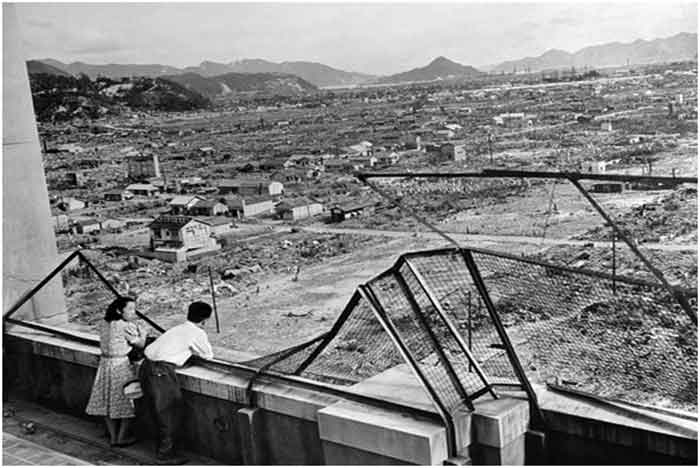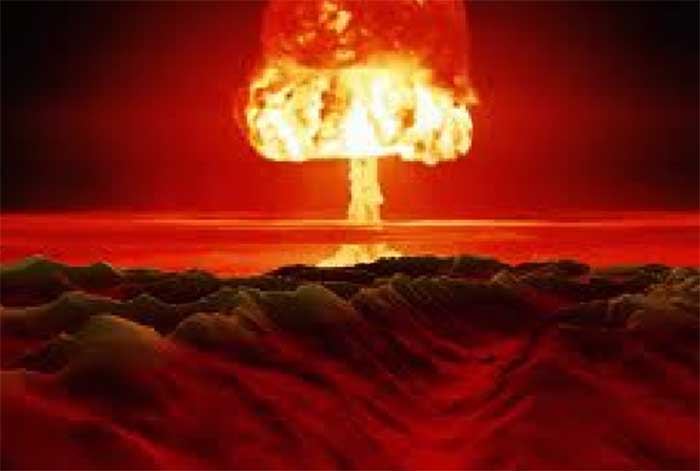
With survival at stake, can weapon makers change course?
Today, the seventy-fifth anniversary of the atomic attack on Hiroshima, should be a day for quiet introspection. I recall a summer morning following the U.S. 2003 “Shock and Awe” invasion of Iraq when the segment of the Chicago River flowing past the headquarters of the world’s second largest defense contractor, Boeing, turned the rich, red color of blood. At the water’s edge, Chicago activists, long accustomed to the river being dyed green on St. Patrick’s Day turned the river red to symbolize the bloodshed caused by Boeing products. On the bridge outside of Boeing’s entrance, activists held placards urging Boeing to stop making weapons.
This summer, orders for Boeing’s commercial jets have cratered during the pandemic, but the company’s revenue from weapon-making contracts remains steady. David Calhoun, Boeing’s CEO, recently expressed confidence the U.S. government will support defense industries no matter who occupies the Oval Office. Both presidential candidates appear “globally oriented,” he said, “and interested in the defense of our country.”
Investors should ask how Boeing’s contract to deliver 1,000 SLAM- ER weapons (Standoff Land Attack Missiles-Expanded Response) to the Kingdom of Saudi Arabia “defends” the United States.
Here are excerpts from Jeffrey Stern’s account of a missile’s impact on the town of Arhab in a remote area of Yemen. In this case, the missile was manufactured by Raytheon:
Now, as Fahd walked into the hut, a weapon about the length of a compact car was wobbling gracelessly down through the air toward him, losing altitude and unspooling an arming wire that connected it to the jet until, once it had extended a few feet, the wire ran out and ripped from the bomb.
Then it was as if the weapon woke up. A thermal battery was activated. Three fins on the rear extended all the way and locked in place. The bomb stabilized in the air. A guidance-control unit on the nose locked onto a laser reflection — invisible to the naked eye but meaningful to the bomb — sparkling on the rocks Fahd walked over.
At the well, at the moment of impact, a series of events happened almost instantaneously. The nose of the weapon hit rock, tripping a fuse in its tail section that detonated the equivalent of 200 pounds of TNT. When a bomb like this explodes, the shell fractures into several thousand pieces, becoming a jigsaw puzzle of steel shards flying through the air at up to eight times the speed of sound. Steel moving that fast doesn’t just kill people; it rearranges them. It removes appendages from torsos; it disassembles bodies and redistributes their parts.
Fahd had just stepped into the stone shelter and registered only a sudden brightness. He heard nothing. He was picked up, pierced with shrapnel, spun around and then slammed into the back wall, both of his arms shattering — the explosion so forceful that it excised seconds from his memory. Metal had bit into leg, trunk, jaw, eye; one piece entered his back and exited his chest, leaving a hole that air and liquid began to fill, collapsing his lungs. By the time he woke up, crumpled against stone, he was suffocating. Somehow he had survived, but he was killing himself with every breath, and he was bleeding badly. But he wasn’t even aware of any of these things, because his brain had been taken over by pain that seemed to come from another world.
In 2019, the UN Group of Eminent Experts on Yemen observed “the continued supply of weapons to parties involved in Yemen perpetuates the conflict and the suffering of the population.”
These experts say “the conduct of hostilities by the parties to the conflict, including by airstrikes and shelling, may amount to serious violations of international humanitarian law.”
A year and a half ago, were it not for a presidential veto, both houses of the U.S. Congress would have enacted a law banning weapons sales to Saudi Arabia.
Another end-user of Boeing’s weapons is the Israeli Defense Force.
The company has provided Israel with AH-64 Apache helicopters, F-15 fighter jets, Hellfire missiles (produced with Lockheed Martin), MK-84 2000-lb bombs, MK-82 500-lb bombs, and Joint Direct Attack Munitions (JDAM) kits that turn bombs into “smart” GPS-equipped guided bombs. Boeing’s Harpoon sea-to-sea missile system is installed on the upgraded 4.5 Sa’ar missile ships of the Israeli Navy.
Apache helicopters, Hellfire and Harpoon missiles, JDAM guiding systems, and Dense Inert Metal Explosive (DIME) munitions have been used repeatedly in Israeli attacks on densely populated civilian areas, resulting in thousands of civilian casualties in Lebanon, the West Bank, and Gaza. The human rights community, including Human Rights Watch, Amnesty International, B’Tselem, and United Nations commissions, ruled these attacks to be human rights violations and at times war crimes.
I lived with a family, in Gaza, during the final days of the 2009 “Operation Cast Lead” bombing. Abu Yusuf, Umm Yusuf, and their two small children, Yusuf and Shahid, welcomed Audrey Stewart and me to stay with them. Once every 11 minutes from 11 p.m. – 1:00 a.m. and again from 3:00 a.m. – 6:00 a.m., we heard an ear-splitting blast. Normally, I wouldn’t have known the difference between the sound of a Hellfire Missile exploding and that of a 500 lb. bomb dropped from an F-15, but soon I could tell the difference. Little Yusuf and Shahid taught us to distinguish one gut-wrenching sound from the other. They had been cringing under the bombs for 18 days and nights.
I don’t see how the sale of weapons to governments which use them against civilian populations, against people like Fahad, in Arhab or Abu Yusuf and his family in Gaza, defends people in the U.S.
Boeing’s vast resources for scientific know-how, skillful engineering, and creative innovation could, however, help defend the U.S. against the greatest threat we now face, environmental climate catastrophe. Writing for The New York Review of Books, Bill McKibben predicts “a century of crises, many of them more dangerous than what we’re living through right now.” The main question, he says, is whether human beings can hold the alarming rise in temperature “to a point where we can at great expense and suffering, deal with those crises coherently, or whether they will overwhelm the coping abilities of our civilization.”
“A rise of one degree doesn’t sound like an extraordinary change,” McKibben writes, “but it is: each second, the carbon and methane we’ve emitted trap heat equivalent to the explosion of three Hiroshima-sized bombs.”
Boeing’s engineers, scientists, designers and marketers could help turn the tide of human actions destroying our earth. Their expertise could truly “defend” people.
There’s a lesson to be learned from the river flowing outside of Boeing’s headquarters. It actually flows backwards. Long ago, brilliant engineers designed a way for the river to reverse its course. In doing so, they saved Chicago from sewage contamination of its drinking water supply – Lake Michigan. This action was hailed as one of the great engineering wonders of the world.
The City’s sewers discharged human and industrial wastes directly to its rivers, which in turn flowed into the lake. A particularly heavy rainstorm in 1885 caused sewage to be flushed into the lake beyond the clean water intakes. The resulting typhoid, cholera, and dysentery epidemics killed an estimated 12 percent of Chicago’s 750,000 residents, and raised a public outcry to find a permanent solution to the city’s water supply and sewage disposal crisis.”
The Sanitary and Ship Canal was constructed at an estimated cost of over $70,000,000. After its completion, in 1900, waterborne disease rates quickly and dramatically improved, and its water supply system was soon regarded as being one of the safest in the world. With its water source made safe and dependable by the canals, Chicago and the region grew and prospered rapidly.
I don’t think it’s a good idea to dye the Chicago River, red or green. We need to protect the river and all wildlife dependent on it. But, we must continually confront Boeing and other weapon manufacturers, and insist they not destroy lives, homes and infrastructures in other lands. We must urge Boeing, like the river, to reverse course and participate, with dignity and humility, in the pursuit of human survival.
Kathy Kelly ([email protected]) co-coordinates Voices for Creative Nonviolence (www.vcnv.org)
SIGN UP FOR COUNTERCURRENTS DAILY NEWS LETTER
















































